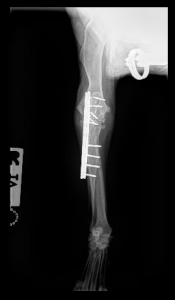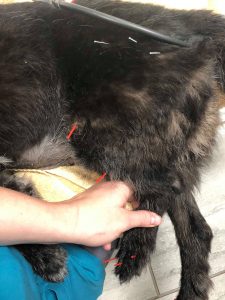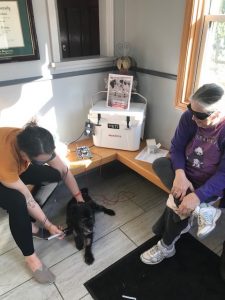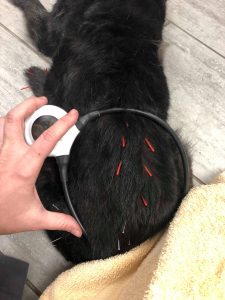Written by a CuraCore Veterinary Medical Acupuncture course graduate. Signed release obtained from client/author 4S2019018
Abstract
This case report describes the clinical management of a geriatric dog with chronic orthopedic issues with an acute worsening of both hindlimb mobility and elbow pain. When the medications she had been on for the past five years were failing to control her pain, other multimodal methods of treatment were utilized to improve and maintain a good quality of life. Her case involves conditions related to internal medicine, intervertebral disc disease (IVDD), orthopedic surgery / implant failure, and senior cognitive dysfunction. The patient responded favorably and recovered well with the use of acupuncture, pulsed electromagnetic field therapy (PEMF), some laser therapy, and slight changes to her pharmaceutical regimen.
History
Mabel, the subject for this case study, is a 14-year-old spayed female terrier mix with an interesting life story. The owners aren’t entirely sure of her age, as she was rescued from the streets of Los Angeles as a young adult. Mabel presented for the first time on July 9, 2019. Her presenting complaint was acute hindlimb paresis as well as worsening right forelimb pain. The right forelimb pain had been a longstanding and progressive issue for approximately 5 years, according to the owner, as she had suffered an “elbow fracture” after being hit by a car that was repaired surgically with good results. Her right forelimb lameness never fully resolved, though, despite the surgery. As Mabel aged, she developed degenerative joint disease and significantly decreased range of motion in that elbow, as well as chronic back pain. Her discomfort was well controlled, up until recently, using carprofen (25 mg twice daily) and gabapentin (100 mg twice daily). Other issues that Mabel has are chronically elevated ALP of unknown origin, as well as signs of progressive geriatric cognitive dysfunction. Mabel’s owner said that she will often become distressed in the middle of the night and doesn’t calm down until her upper abdomen is massaged. She believes that these events are related to abdominal pain. This issue, possibly in relation to her elevated ALP, had never been worked up previously by any of her former veterinarians.
About two weeks prior to presentation, Mabel escaped from her yard and went missing for multiple nights. When the owners found her, she was non-weight bearing on her right forelimb. She struggled significantly just to get around and the owners noticed her slipping and falling a lot as she was only using three legs and was very unstable. The owner also reported that her medications were no longer controlling her pain. Not much time had passed after the disappearance when the owner witnessed Mabel suddenly had little to no control of her legs and they would completely splay out laterally on uncarpeted flooring. She seemed very painful, would cry out when picked up, and often collapsed on her hind end and could not stand up again. She had no changes in her urine or fecal incontinence. It was at this point that Mabel’s owner scheduled a vet appointment to try to find out what could have caused this somewhat rapid deterioration.
Physical Examination and Clinical Assessments
On presentation, Mabel was stand-offish, but not fearful. She would quickly proceed to growl or even attempt to bite if touched. On the tiled floor of the clinic, Mabel was unable to walk without being totally supported. Her hind limbs were extremely ataxic, and she was only toe-touching her right forelimb but not bearing any weight on it. She could only walk a few steps on her own, even on carpet, and her gait was three-point in nature. She would just barely toe-touch with her right forelimb as if for some sort of stabilization, and then slowly shuffle each hindlimb forward, one by one. If placed on a slippery surface, Mabel had little to no ability to hold her hind limbs in a standing position but she could bear weight on them if put on carpet.
As an older dog, Mabel had significant dental disease (Grade 4/4) and nuclear sclerosis bilaterally. Her heart and lungs auscult within normal limits and her abdomen was tense but not painful. Her right elbow was significantly swollen, very painful, and had very limited range of motion. She had tension at the insertion of the triceps and some taut bands in the right side of her cervical region. When palpating her thorax, she would flinch repeatedly in a variety of spots throughout her latissimus dorsi. Her neurologic findings of both forelimbs were unremarkable and no crossed extensor reflex was evident. Palpating along her spine, she started to exhibit signs of discomfort at the mid-lumbar region and would growl and attempt to turn around when her lumbosacral region was palpated. Range of motion of her hips, stifles, and hocks were relatively normal and did not elicit pain. She was very tense in both right and left quadriceps and reacted painfully when taut bands on the cranial side of her thigh were strummed. Neurologic findings in her hindlimbs were absent proprioception bilaterally, normal to decreased reflexes bilaterally with a clonic motion exhibited after the reflexive “kick” was elicited, and she had a positive crossed extensor reflex on both sides. Mabel’s clinical findings and neurologic exam was consistent with a L4-S2 myelopathy. Radiographs were taken of her spine on her day of initial presentation, revealing a significant loss of intervertebral disc space at L6-L7 as the most prominent finding (Figure 3).


Differential Diagnoses (Ddx):
— Ddx for acute onset of hindlimb ataxia: Taking the sudden onset of her condition into consideration, intervertebral disc disease was the number one differential; her neurologic findings localized to an L4-S2 myelopathy. Other differentials could include a peripheral nerve damage, spinal artery thrombosis, or (less likely) some form of cerebellar or vestibular disease.
— Ddx for right elbow lameness: Mabel’s history of trauma and surgical repair to her elbow was the definite predisposing factor for this problem. However, her elbow had acutely become more painful and actually developed an acute swelling. Since the surgery was at least 5 years prior, differentials for this sudden exacerbation of her condition include some sort of implant failure, pathologic fracture associated with osteomalacia that developed over time due to the presence of a very large bone plate, or neoplasia.
— Ddx for chronically elevated ALP and suspected abdominal pain: Many of Mabel’s regular behaviors (confusion at night, polyuria and polydipsia, ravenous appetite, dull haircoat, potbellied abdomen) could actually be symptoms of undiagnosed hyperadrenocorticism. Cushing’s Disease can cause ALP to increase as a result of elevated endogenous steroid levels, affecting the liver and potentially predisposing Mabel to the formation of a gallbladder mucocoele. Other possibilities include chronic hepatitis (less likely given normal ALT), neoplasia (bile duct carcinoma, pancreatic carcinoma, lymphoma), various inflammatory conditions (cholangitis, chronic pancreatitis), and/or secondary to increased osteoblastic activity associated with bony remodeling related to the aforementioned elbow pathology, especially if bone cancer may be involved (Stockham & Scott, 2008).
Definitive Diagnosis
1.) L4-S2 Myelopathy (no MRI was pursued; therefore, the exact cause cannot be definitively stated, however lumbosacral intervertebral disc disease is highly likely), 2.) Geriatric cognitive dysfunction, 3.) Gallbladder mucocoele (diagnosed via ultrasound), 4.) Chronic pancreatitis, 5.) Osteoarthritis in right elbow
Medical Decision Making & Outcomes
Based on Mabel’s initial presenting complaint, acute hindlimb ataxia, an acupuncture session was initiated to help treat her suspected intervertebral disc disease. Because I had yet to gain Mabel’s trust, and she had a tendency to become aggressive, the first needling session was somewhat conservative. The focus was her lumbar spine, hindlimbs, and distal extremities. Because of the chronicity of her elbow, based on the history given by Mabel’s owner, not a lot of focus was put on needling around that region. I initiated the needling with points known to target the parasympathetic nervous system in an attempt to decrease sympathetic tone.
My overall goal was to provide peripheral and somatic nerve stimulation to enhance communication between nerves coursing throughout the distal extremities via reflexes up to the spinal cord. Other benefits of the points that I selected were, again, to decrease sympathetic tone as well as increase blood flow to the areas needled, thereby improving the circulation of endogenous opioids, and anti-inflammatory substances. For her first session, silicone-coated Seiran needles were selected. Mainly red Seirans (0.16 mm) were used for the extremities, while Mabel readily accepted blue Seirans (0.20 mm) in her bladder line and hip regions. She responded very well to my protocol and within four sessions, Mabel was walking independently.
Mabel’s case eventually became very multifactorial and complicated. While Mabel’s right forelimb continued to be non-weight-bearing, and the joint swelling became more and more apparent, radiographs were taken and revealed that Mabel had recently broken 2 pins and 3 out of the 7 screws in her 9-hole bone plate (Figure 2). Deep palpation of the elbow revealed that motion was detectable in the area of the screws upon flexion and extension of the joint, as well as significant pain. The decision was made to remove the hardware in Mabel’s right elbow. Even if she hadn’t snapped the screws, it has been shown that large bone plates left on distal extremities for long periods of time can contribute to problems. Bone plates conduct heat and cold making them potentially uncomfortable in different environments. Also, the presence of a large bone plate can contribute to resorption of the bone underneath the plate predisposing it to pathologic fractures (Borgave, Awati, & Deshmukh 2018). The surgery was performed on August 1; all screws were retrieved and Mabel did well under anesthesia. After surgery, her acupuncture regimen was once weekly for about 4 weeks, then she dropped down to bi-weekly thereafter.
About a month after surgery, Mabel suddenly became lethargic and non-appetent. She also developed an acute worsening of abdominal pain. Her bloodwork revealed further elevation of her liver enzymes and pancreatitis. She was hospitalized for 5 nights on IV fluids before she started to make a recovery and regain her normal ravenous appetite once again. Carprofen was discontinued, as it may or may not be implicated in the elevated liver values. She was managed on Galliprant, gabapentin, ursodiol, and joint supplements from there on out.



Acupuncture Points
Initially after intervertebral disc herniation event (July 9 – July 20):
– Needle selection: Primarily 0.20 mm Seirans and 0.20 mm Carbos
– Autonomic Points to diminish heightened sympathetic tone: GV20, GV14, BaiHui, ST36
– Trigger points along bladder line between BL24-BL28 targeted to stimulate spinal nerve roots surrounding the suspected area of the herniated disc
– Points on distal extremities to communicate with sciatic and femoral nerves: GB29, GB30, BL54, ST35, ST36, BL60, KI3, BaFeng, KI1
– Addition of Assisi loop therapy on right elbow for 15 minutes following treatments
Post-operative treatments and continued maintenance of therapy for back pain (August 5 – 25):
– No change in aforementioned points for maintenance of IVDD
– Addition of SP6 and SP9 to stimulate the tibial and saphenous nerve to promote communication with chosen bladder line points
– Needling near the elbow was kept to a minimum, as Mabel was extremely painful and did not tolerate much in this area. Selected points included BL9-12, GV14, GB20-21, SI3, as well as local trigger points in the cervical muscles and latissimus dorsi that varied from week to week. Any needling done in Mabel’s surgical limb was done using 0.16 mm Seirans.
– Addition of two treatments of laser therapy (Figure 1). I used the pre-set settings for elbow and spine, treating both of these regions at two different sessions two days apart. This was a demo laser that did not possess the ability to create custom settings or choose your dose applied to the area.
– Regular nightly treatments using PEMF therapy at home administered by the owner
– Continued maintenance and addition of points to manage abdominal pain associated with chronic pancreatitis and gallbladder mucocoele (August 26 – Present):
– All of the above, with less and less focus on the elbow as recovery progressed. The owner continues to use the Assisi loop on Mabel’s elbow on an almost daily basis
– Addition of BL17 – BL21 as these are the shu points for many of the cranial abdominal organs that started causing issues for Mabel related to her pancreas, liver, and gallbladder
Overall Experience
Mabel was a complicated and multifactorial patient that challenged me to utilize my skills in traditional medical management, orthopedic surgery, and my newfound skillset in integrative medicine techniques. This case allowed me to explore ways to improve a patient’s quality of life and, especially for a geriatric patient, greatly hasten recovery time from an initial paralyzing injury as well as major orthopedic surgery. I was amazed to see that after just one acupuncture session following Mabel’s initial IVDD event, she was able to bear weight and walk on carpet. After two treatments, she was walking on tile. The experience was very eye-opening and rewarding for everyone involved. While Mabel’s issues will never be “fixed,” I believe that the use of acupuncture and other non-traditional approaches of treatment has not only improved her quality of life and strengthened the bond between Mabel and her owner, as well as Mabel’s owner and myself.
References
Stockham, S. L., & Scott, M. A. (2009). Fundamentals of Veterinary Clinical Pathology (2nd
ed.). Ames, IA: Blackwell Publishing.
Borgave, S. A., Awati, S. S., & Deshmukh, R. M. (2018). Limitations of Current Metallic Bone
Plates: towards Development of Composite Bone Plates. Journal of Mechanical and Civil
Engineering, e-ISSN: 2278-1684, 45–49. Retrieved from http://www.iosrjournals.org/iosr-
jmce/papers/NCRIME-2018/Volume-5/10. 45-49.pdf